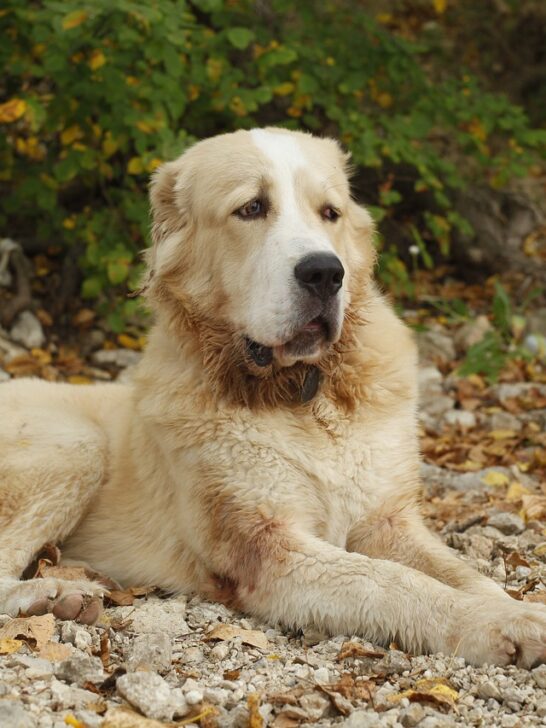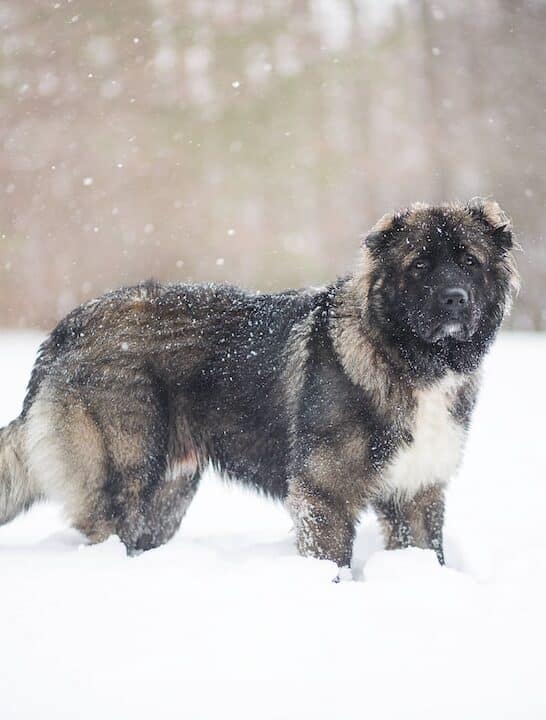White Swiss Shepherd: Meet the Beautiful Berger Blanc Suisse Herding Dog
The White Swiss Shepherd is an unmistakably beautiful medium-sized dog breed. But these dogs are not as rare as their iconic white coat might suggest.
While the White Swiss Shepherd is named for the country of Switzerland, these dogs in fact got their start in Germany at the same time another beloved dog breed, the German Shepherd, was being developed.
Learn the interesting story behind the evolution of the White Swiss Shepherd.
And find out much more about these wonderful dogs, including facts on personality and temperament, training and exercise, health, and life expectancy.
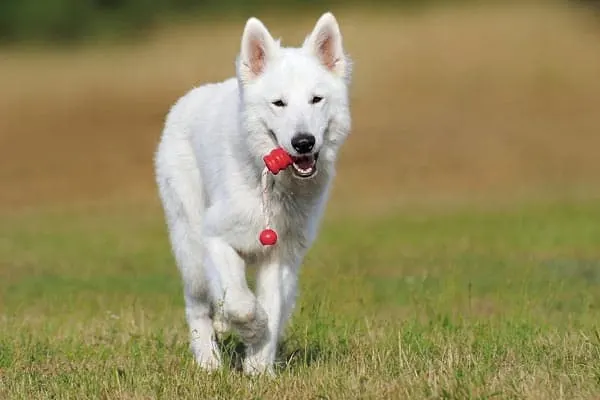
White Swiss Shepherd
The White Swiss Shepherd is known by several names, including the White Shepherd, the Berger Blanc Suisse, and the Snowy Shepherd. All are referring to the same dog with a gorgeous white coat.
What is so interesting about the White Swiss Shepherd is that this dog actually hails from Germany and shares a breed line with the original German Shepherd dogs developed by Captain Max Von Stephanitz.
See the Beautiful Berger Blanc Suisse As a Puppy and Adult Dog
This short and sweet YouTube video is a great way to get introduced to the White Swiss Shepherd dog, otherwise known as the Berger Blanc Suisse.
The History of the White Swiss Shepherd Dog Breed
According to Dances With Wolves Ranch breeder, the White Swiss Shepherd dog got their start in Germany at the same time the German Shepherd dog got their start.
In fact, the White Swiss Shepherd technically predates the German Shepherd. The first purebred German Shepherd was registered in 1899.
This dog’s name was Horand von Grafrath. Horand’s grand-sire was a white shepherd named Greif.
This is the dog that ties the German Shepherd to the White Swiss Shepherd. However, it is believed that the White Swiss Shepherd far predates the GSD.
As Moro Shepherds breeder describes, the White Swiss Shepherd dog breed originally hailed from the German state of Thuringia.
These dogs were first called Thuringian Shepherds.
Thuringian Shepherds were not all white-coated like the White Swiss Shepherd.
However, thanks to careful breeding records, modern White Swiss Shepherd breeders know that Greif, the dog used in the formation of the German Shepherd breed, was a white-coated Thuringian Shepherd dog.
White Swiss Shepherd dogs were not known in the United States until the early 20th century.
In fact, the canine movie star known as Strongheart was born from the Thuringian Shepherd line and went on to breed more White Swiss Shepherds.
Once the German Shepherd dog breed standard was formalized, it stated that white-coated GSDs were to be disqualified for show competition purposes.
This has led to a push to recognize the White Swiss Shepherd as a separate dog breed altogether.
Today, the White Swiss Shepherd is formally recognized as a separate Switzerland-based dog breed by the fédération cynologique internationale (FCI World Canine Organization) and by the United Kennel Club in the UK.
However, the American Kennel Club (AMK) still does not recognize this dog breed.
The AKC recognizes the White German Shepherd but disqualifies these dogs for AKC show competitions.
In the United States, there are two separate independent dog clubs that represent the White Swiss Shepherd dog breed – the Berger Blanc Suisse dog club and the White Swiss Shepherd Club of America.

White Swiss Shepherd Size, Height and Weight
It probably won’t surprise you to learn that the White Swiss Shepherd has a very similar size, height, and weight to the modern German Shepherd dog.
According to the White Swiss Shepherd dog breed standard, this dog is always white-coated.
The measurements are given in the metric system (United States equivalents are provided for convenience here).
Adult male White Swiss Shepherd dogs
- Height (paw pads to shoulder tops): 58 to 66 cms (22 to 25 inches)
- Weight: 30 to 40 kgs (66 to 88 pounds)
Adult female White Swiss Shepherd dogs
- Height (paw pads to shoulder tops): 53 to 61 cms (20 to 24 inches)
- Weight: 25 to 35 kgs (55 to 77 pounds)
While the United Kennel Club (UKC) specifically notes that these dogs are considered to be “medium-sized,” the measurements you just reviewed would indicate the Berger Blanc Suisse can be a quite large dog weighing nearly 90 pounds!
Another unique attribute of the White Swiss Shepherd is how much of a height and weight difference typically exists between females and males of the breed.
This is similar to the gender differences seen in purebred German Shepherd adult dogs as well.
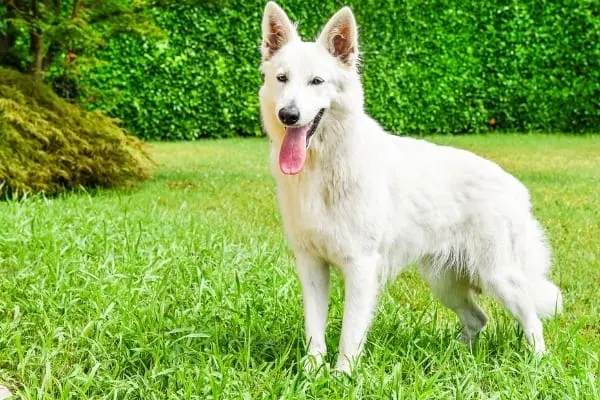
White Swiss Shepherd Personality and Temperament
The White Swiss Shepherd may not be a recognized and registered American Kennel Club (AKC) purebred dog breed, but as you now know, the dog breed itself is actually considered to predate the AKC-registered German Shepherd.
And while the Berger Blanc Suisse breed is still considered to be a rare breed overall, they are becoming surprisingly popular with breeders and dog lovers in recent years.
As Hula Moon Berger Blanc Suisse breeder states, while there are many personality and temperament similarities between the GSD and the BBS, the latter tends to be more mild, patient, and balanced in temperament.
This can make the Berger Blanc Suisse dog a better choice for a family protection dog if your family includes young children or other family pets.
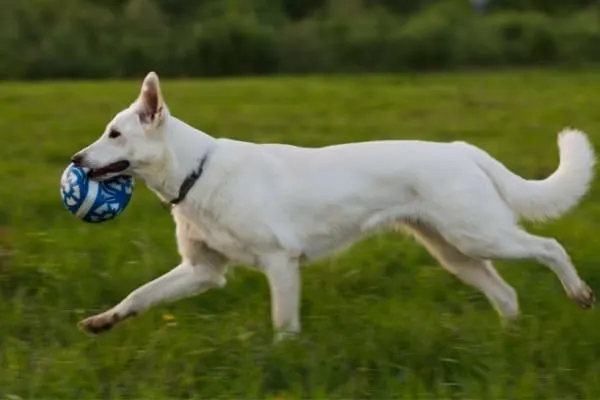
White Swiss Shepherd Socialization and Training Needs
The Berger Blanc Suisse dog is a herding dog through and through. As such, these dogs do need early and ongoing training and socialization.
And they may have trouble curbing their instincts to herd people, including children.
Overall, like their genetic relatives the German Shepherd, the White Swiss Shepherd will be warm and affectionate with “their” people but aloof and reserved with unknown people and animals.
This is why it is so important to start socializing and training a White Swiss Shepherd puppy as early as possible.
These dogs need to learn how to accept visitors and guests to the home and how to behave calmly around strange people and animals out in public.
Because the White Swiss Shepherd is a “people” dog through and through, these dogs also need to live in the house with their human family and be a central part of daily life.
They don’t do well when confined to the yard or left alone for long periods regularly.
Getting another family dog is also not going to be an adequate substitute for the company of people.
These dogs are social and people-focused and develop very strong bonds with their human family.
The smart White Swiss Shepherd that gets lonely or bored is likely to become destructive and develop problem behaviors like barking or inappropriate elimination.
White Swiss Shepherd Exercise and Activity Level
While the white Swiss Shepherd has a calmer temperament overall than the German Shepherd, these dogs are still considered to be high energy herding dogs overall.
As a herding dog breed, the Berger Blanc Suisse has been bred to have a hardy constitution and to be able to work long hours at a challenging job in difficult weather without getting tired.
This means that the White Swiss Shepherd will not do well living the life of a couch potato pet dog. They need to stay busy and active to keep out of trouble.
The best fit for a White Swiss Shepherd is an individual, couple, or family who likes to stay active, be outdoors, and do sports that their dog can do with them.
White Swiss Shepherds excel at K-9 athletics such as rally, agility, fly ball, disc dog, conformation, obedience, nose work, search and rescue, Schutzhund, and more.
As Vom Hundhaus breeder relates, the White Swiss Shepherd can easily jump over a six-foot fence to chase down a ball (or a target).
This also means you will need to make sure your backyard is fenced and completely secure and escape-proof.
Because the White Swiss Shepherd is a herding dog breed with a strong instinct to chase and a strong prey drive, if this dog manages to escape, it is quite possible they will meet with an accident due to traffic or get so lost you won’t be able to be reunited.
As an owner of a working canine breed like the White Swiss Shepherd will say, a happy herding dog is a tired herding dog.
These dogs love to stay busy and active and you will have a much calmer dog at home if you can meet your dog’s need for exercise.
The one caveat to this is that you should avoid too-strenuous exercise until your White Swiss Shepherd dog is done growing.
The best way to know your dog is done growing is to ask your canine veterinarian to X-ray the long leg bones. This will verify whether the growth plates have closed and hardened.
Once this has occurred, you can allow your dog to run and jump and hike and fetch and play to their heart’s content without any worry of doing damage to the joints.
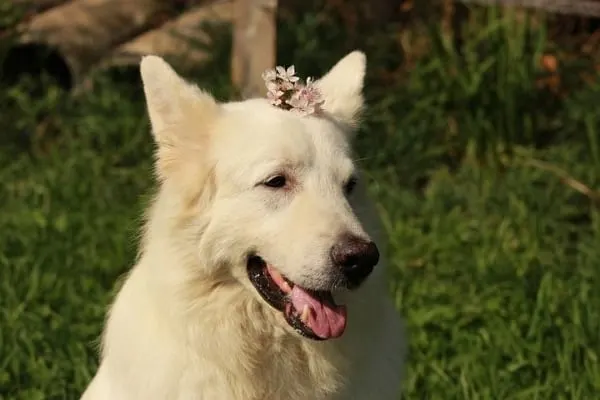
White Swiss Shepherd Coat Care and Grooming
As World Dog Finder points out, the White Swiss Shepherd dog’s eye-catching white coat is one of the hallmarks of this dog breed.
However, the Berger Blanc Suisse is first and foremost a working dog breed. And as a working dog breed, you will have year-round and seasonal shedding to deal with.
Since the coat color is white, this means you will also be coated with white dog hair.
Like all puppies, the White Swiss Shepherd will have a single coat in puppyhood.
But starting around six months or so, the puppy coat will begin to shed out and be replaced by the adult dog coat.
Herding dogs, like all working dog breeds, have a thick double-layer coat. The innermost layer (closest to the dog’s skin) is made up of a thick, very soft, insulating undercoat.
This layer keeps the dog warm and dry.
The outermost layer is a longer, coarser, water-resistant layer that is designed to repel moisture, cold, pests, sunlight, and other health dangers.
Both layers will shed out lightly year-round to make sure the coat retains all of its protective properties.
The undercoat will shed out heavily on the changing of the seasons in what many owners call the “coat blow.”
This is the time when you will want to keep a de-lint brush, dustpan, and broom and vacuum cleaner handy.
And you will need to get used to doing daily brushings to keep the shed hair under control.
Luckily, aside from regular brushings and the occasional bath, your dog’s coat won’t need a lot of other maintenance.
However, you will need to brush your dog’s teeth and check your dog’s ears regularly and clean them as needed.
And your dog will need periodic toenail trims to keep the nails from getting overgrown.
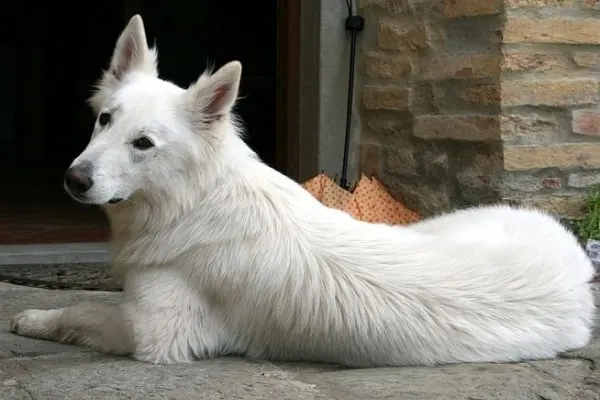
White Swiss Shepherd Health and Life Expectancy
Overall, the White Swiss Shepherd has been considerably less inbred than the German Shepherd over the decades.
This is actually part of the reason that there has been a resurgence of interest in the White Swiss Shepherd – quite separate and apart from their milder, calmer temperament and beautiful white coats.
The White Swiss Shepherd is stronger and healthier genetically and physically in many important ways, especially when it comes to back and spine health.
MDR1 drug sensitivity
As Wisdom Panel points out, one health issue that White Swiss Shepherd owners need to know about is their inborn genetic sensitivity to many medications, including anesthesia.
There is a mutation to the MDR1 gene that some White Swiss Shepherd dogs inherit that can cause potentially severe side effects from some drugs.
Because of this, it is important to make sure your canine veterinarian is experienced at treating White Swiss Shepherds and other breeds with this type of genetic sensitivity to medications.
Hip and elbow dysplasia and other joint issues
Like the German Shepherd and many other large breed dogs, the White Swiss Shepherd also has known issues with inherited joint malformation, including hip and elbow dysplasia.
Dysplasia is a condition that causes the ball and socket joint to not form properly.
Mild cases can usually be managed with medication and physical therapy. Severe conditions require a full joint replacement on par with human joint replacement.
Other joint issues can also be present in this dog breed, as the White Swiss Shepherd Club of the UK points out.
Skin and digestive allergies
The White Swiss Shepherd is known to have genetic skin allergies and can also have a sensitive stomach and food allergies.
Gastric dilatation (bloat)
One of the most concerning genetic health issues that can affect the White Swiss Shepherd is caused not by specific genes but by their body structure.
Dogs with deep, narrow chests are more prone to a potentially fatal condition called gastric dilatation or bloat.
Bloat occurs when the stomach gets twisted inside the chest and fills with gas. The twisting cuts off blood circulation and there is a risk of a stomach rupture.
The best way to prevent bloat is to ask your canine veterinarian to do a simple preventative surgery at the same time your dog gets spayed or neutered.
Otherwise, even early detection and intervention is often not enough to prevent a fatality.
Overall, the White Swiss Shepherd dog’s life expectancy is slightly improved over that of the German Shepherd.
On average, the White Swiss Shepherd typically lives eight to 14 years.
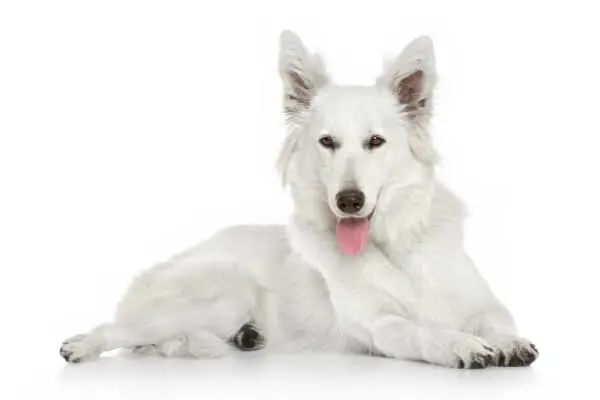
Is the White Swiss Shepherd the Right Dog Breed for You?
The White Swiss Shepherd is gaining popularity in the United States and internationally for a number of very good reasons.
These dogs are genetically healthier than their wildly popular canine relatives, the German Shepherd.
They have a generally sturdier build with fewer back problems and joint problems.
The White Swiss Shepherd dog is also known to have a milder temperament that makes them easier to train and socialize, especially for families who have young children in the household.
And the Berger Blanc Suisse dog is an undeniably beautiful dog, with their lush white coats and regal bearing.
However, White Swiss Shepherd dogs are herding dogs with a strong chase instinct and prey drive.
They can be escape artists and don’t do well with a sedentary daily life or with being left alone – even in the company of other dogs.
A White Swiss Shepherd is a good choice if you want to lead an active, athletic lifestyle that your dog can join in with you.
If you want a companion canine who will be at the center of your life, the White Swiss Shepherd will be a loyal and loving protector and friend that will put you at the center of their world in turn.


















